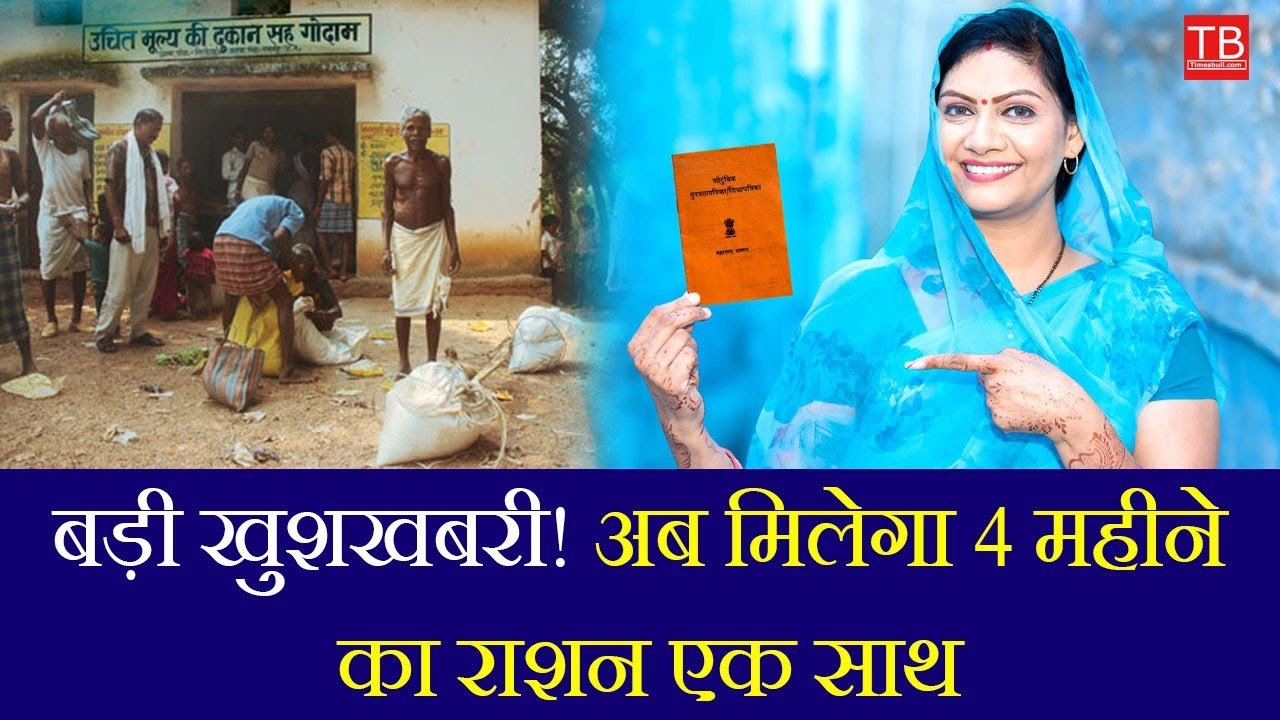Now All Ration Card Holders Will Get 3 Months’ Ration at Once – Full Details, Eligibility, Process, and Official Update
Government welfare schemes in India have always focused on ensuring food security for the poor and economically weaker sections of society. One of the most vital schemes among them is the Public Distribution System (PDS), which provides subsidized food grains through ration cards. Recently, the government has announced a big relief for ration card holders: all beneficiaries will now receive 3 months’ ration at once. This step is expected to ease the burden of frequent visits to ration shops and ensure timely availability of food grains for millions of families.

In this detailed article, we will cover everything you need to know about this update – eligibility, distribution process, documents required, benefits, and step-by-step instructions on how ration card holders can avail themselves of the 3 months’ ration facility. This guide is written in a simple, humanized tone to ensure every reader understands the policy clearly.
📌 Key Highlights
Feature | Details |
|---|---|
Scheme | Public Distribution System (PDS) / Ration Card Holders |
New Update | 3 months’ ration at once for all cardholders |
Beneficiaries | All NFSA and State Ration Card holders |
Type of Grains | Rice, Wheat, Sugar, Kerosene (as per entitlement) |
Implementation | Across India under central and state coordination |
Benefit | Hassle-free access to food grains for 3 months |
🔎 Background of the Ration Card System in India
Ration cards are more than just a food distribution mechanism – they are an important identity document for low-income families in India. Through the National Food Security Act (NFSA), eligible families receive subsidized rice, wheat, and other essentials. Every state issues ration cards under categories like APL (Above Poverty Line), BPL (Below Poverty Line), and Antyodaya Anna Yojana (AAY).
The government provides these grains through Fair Price Shops (FPS), commonly known as ration shops. Until now, beneficiaries had to collect their monthly quota every month, which often caused difficulties for daily wage earners, women, elderly citizens, and people living in remote areas.
To resolve this, the government has introduced a system to provide 3 months’ ration at once, which ensures better convenience and security.
📝 Why the Government Introduced the 3-Month Ration System?
The move to distribute ration for three months in advance has multiple objectives:
- Convenience for Beneficiaries – Families no longer need to make monthly trips to ration shops.
- Reduced Crowding – Fewer visits to ration shops reduce overcrowding and waiting times.
- Food Security Assurance – Ensures that every household has a stock of essential food grains.
- Emergency Preparedness – Useful during natural calamities, lockdowns, or unforeseen situations.
- Time and Cost Saving – Saves travel costs and time for poor families.
📂 Types of Ration Cards Eligible
The 3-month ration facility will be applicable to the following categories:
Ration Card Type | Eligibility |
Antyodaya Anna Yojana (AAY) | Poorest of the poor families |
Priority Household (PHH) | Families identified under NFSA |
Below Poverty Line (BPL) | Families with income below state poverty limit |
Above Poverty Line (APL) | Depending on state policies, some may also get benefits |
🛒 What Will You Get in 3 Months’ Ration?
The quantity of grains and items may vary from state to state, but generally, the following items are provided:
Item | Monthly Quota (per person/household) | For 3 Months (approx.) |
Rice | 5 kg per person | 15 kg per person |
Wheat | 5 kg per person | 15 kg per person |
Sugar | 1 kg per household | 3 kg per household |
Kerosene (where applicable) | 3–5 liters | 9–15 liters |
(Note: Actual entitlements depend on state-specific PDS rules.)
📌 Eligibility Criteria
To avail of this facility, beneficiaries must:
- Hold a valid ration card under NFSA or state scheme.
- Be an active beneficiary (not a duplicate or cancelled card).
- Complete e-KYC/biometric verification if required.
- Ensure Aadhaar linkage with ration card (mandatory in many states).
🛠️ Step-by-Step Process to Avail 3 Months’ Ration
- Check Notification – Visit your state’s Food & Civil Supplies Department website.
- Visit Ration Shop (FPS) – Go to your assigned fair price shop.
- Provide Ration Card & Aadhaar – Verification may be done via biometric fingerprint scan.
- Collect Food Grains – The dealer will issue ration for 3 months at once.
- Keep Receipt – Always take a printed or digital receipt for proof.
🌍 States Implementing the 3-Month Distribution Policy
Several states have already started distributing ration for 3 months, while others are in the process of rolling it out. States like Uttar Pradesh, Bihar, Madhya Pradesh, Rajasthan, and Odisha are among the first to adopt this system.
📈 Benefits of 3-Month Ration Distribution
- Ensures food security for poor households.
- Reduces corruption and leakage in monthly distribution.
- Supports women and elderly citizens who face difficulty in monthly visits.
- Improves efficiency of fair price shops.
- Prevents disruption during disasters like floods, droughts, or pandemics.
⚠️ Possible Challenges
While the scheme is highly beneficial, there are a few challenges:
- Storage issues at the household level.
- Risk of selling ration in black markets.
- Fair price shop owners may face stock management issues.
- Need for strict monitoring to prevent misuse.
🧾 Documents Required
- Ration Card (Original + Copy)
- Aadhaar Card of family members
- Mobile Number linked with Aadhaar
- Recent Passport-size Photograph (if demanded)
- State-specific ID proof (if required)
📞 Helpline Numbers for Ration Card Holders
State | Helpline Number |
Uttar Pradesh | 1800-1800-150 |
Bihar | 1800-3456-194 |
Madhya Pradesh | 1967 / 1800-2333-676 |
Rajasthan | 1800-180-6030 |
Odisha | 1967 |
(Check your state PDS website for latest numbers.)
📰 Latest Government Update
According to the Ministry of Consumer Affairs, Food & Public Distribution, the scheme will be monitored through digital ration distribution systems (ePOS machines, Aadhaar authentication, and SMS alerts). This ensures transparency and prevents duplicate withdrawals.
💡 Expert Opinion
Economists and social experts believe that this step will strengthen food security in India. However, they stress the need for awareness campaigns, vigilant monitoring, and beneficiary feedback systems to ensure the scheme runs smoothly.
✅ Conclusion
The decision to provide 3 months’ ration at once to all ration card holders is a landmark step in India’s welfare policy. It not only ensures food security but also provides dignity and relief to millions of families. Beneficiaries must ensure they keep their ration card updated, Aadhaar linked, and stay informed about official notifications to avail of this benefit without any difficulty.
📌 Disclaimer
This article is intended for informational purposes only. The information provided here is based on government announcements, official sources, and state PDS guidelines. However, ration entitlement, distribution process, and eligibility criteria may vary from state to state. Beneficiaries are advised to verify details from their respective State Food & Civil Supplies Department or official government website before proceeding. We do not take responsibility for any discrepancies or policy changes.
